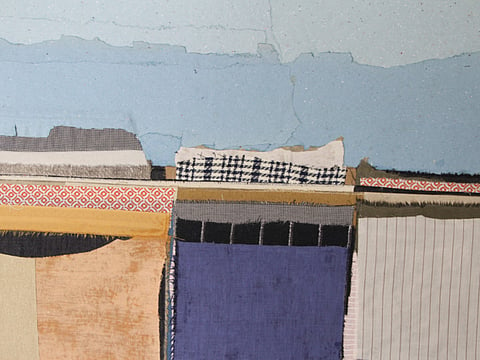A homage to Palestinian art, culture and heritage
Sliman Mansour, Hazem Harb and Mohammed Joha address themes of identity, belonging and loss

El Beit, the latest exhibition at Tabari Artspace explores the collective experience of lost identity and displacement in Palestine through the work of three modern and contemporary Palestinian artists, Sliman Mansour, Hazem Harb and Mohammed Joha. The show’s title, which means ‘feel at home’ in Arabic reflects the themes of identity, belonging and loss addressed by the artists through their paintings, sculptures and photographic works.
Although the three artists belong to different generations and have different styles, they are all interested in looking at the collective Palestinian memory and its role in shaping national identity and historic legacy. By setting up a dialogue between them, the show highlights the ongoing impact of the Palestinian-Israeli conflict whilst offering an insight into the variety of art practices and perspectives in Palestine today.
Visual documentation
Mansour is a pioneer of modernist art in Palestine and is one of the most respected and recognised Palestinian artists. He has dedicated his career to creating a visual documentation of the Palestinian struggle throughout history and the hardships of daily life in the region.
The artist, who was born in Birzeit in 1947, continues to live in Palestine and has been actively involved in the local art scene. He was the head of the League of Palestinian Artists in the late 1980s and later co-founded and served as the director of the Al-Wasiti Art Centre in East Jerusalem. He also played a key role in establishing the International Academy of Art Palestine in Ramallah and the University Art Centre in East Jerusalem.
Father and mother on their wedding day, 1984 oil on canvas , 92 X85 cm
When the first Intifada began in 1987, Mansour founded the New Visions art movement, which decided to boycott art supplies imported by the Israelis. So the artists began to use natural materials sourced from the environment such as mud, henna and clay.
Mansour’s series, Ten Years in Mud, displayed in the show is part of this exploration of his homeland. The artist has used mud on wood panels to create houses and figures that depict both the land and its people with the cracks in the dried mud evoking the passage of time and the continued suffering of the people.
Harb was born in 1980 in Gaza and currently lives between Rome and Dubai. He is showing a series of collages that are inspired by a lake in the city of Tiberias, which Palestinians revere as a sacred area. The city itself was an important centre in Palestine until the Arab revolt of 1936, which is a central theme in Harb’s works. The artist has combined archival images of Lake Tiberias with his own photographs of the area to create his poignant collages.
He has transformed one part of the gallery into a domestic setting with an installation featuring an enlarged archival image of the interior of a home located on the lake. Displayed alongside this image are two well-known paintings by Mansour.
These include Girl in the Village depicting a young woman dressed in a traditional Palestinian thobe framed by an abstract landscape that is evocative of Palestinian tradition and sentimentality; and Father and Mother on their Wedding Day, showing Mansour’s parents in traditional wedding garments surrounded by olive trees, which are a powerful symbol of national identity and connection to the land for Palestinians.
The installation conveys a sense of nostalgia, longing and displacement; but it also sets up a conversation between the two artists of different generations in a familiar setting, allowing them to rebuild and re-imagine a homeland that remains inaccessible.
Joha was born in Gaza in 1978 and is currently based in Italy. He is exhibiting 14 collages on paper, created from fabric, cardboard and paper that speak about the destruction of Palestinian homes throughout the conflict. While some of the homes in his collages are drawn from his memories, others come from his imagination addressing themes of childhood, loss of innocence, freedom and identity.
The similar themes of the three artists are a reminder of the long struggle and decades of challenges faced by Palestinians. But they also indicate that the younger artists are continuing the fight begun by an older generation to demand justice for the displaced people of Palestine.
This show is part of a series of exhibitions titled From Palestine With Love hosted by the gallery to celebrate Palestinian culture, art and heritage through the work of prominent Palestinian artists.
The series began in January with a show of unique artworks by Naqsh collective, which has been shortlisted for this year’s Jameel Prize. The collective was founded by Amman born architect Nermeen Abudail and her sister Nisreen Abudail, who is a graphic designer. They showcased a new series of works featuring motifs from traditional Syrian and Palestinian cross-stich embroidery engraved on wood, stone, brass and marble.
El Beit will run at Tabari Artspace, DIFC until March 8.
Sign up for the Daily Briefing
Get the latest news and updates straight to your inbox


